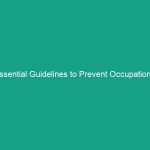Introduction
Good morning team! Today, we are going to discuss a crucial topic that impacts each of us every day at work: Must-Know Guidelines for Taking Action to Work Safe Every Day. This conversation is essential because Workplace Safety is not just a set of rules; it’s a culture that protects our well-being and enhances our productivity. By understanding and implementing these guidelines, we can minimize risks and create a safer Environment for everyone.
Understanding Must-Know Guidelines for Taking Action to Work Safe Every Day
The phrase Must-Know Guidelines for Taking Action to Work Safe Every Day encompasses the essential practices and protocols that each employee should be aware of and follow to ensure their Safety and the Safety of their colleagues. These guidelines are vital because they provide a framework for identifying Hazards, assessing risks, and implementing effective Safety Measures. Ignoring these practices can lead to accidents, injuries, and even fatalities, which can have severe implications both personally and professionally.
Many people might think that safety is only a concern for those in high-risk jobs, but the reality is that every workplace has its Hazards. Understanding these guidelines ensures that everyone is equipped to recognize and mitigate risks.
Key Hazards, Risks, and Safety Considerations
Every workplace has inherent hazards that can lead to accidents and injuries. Here are some common hazards you should be aware of:
- Slips, Trips, and Falls: Often caused by wet or uneven surfaces, cluttered walkways, or unsecured rugs.
- Ergonomic Hazards: Poor workstation setup can lead to long-term musculoskeletal disorders.
- Electrical Hazards: Exposed wires or overloaded circuits pose serious risks.
- Hazardous Materials: Chemicals and substances that require proper handling and storage.
Ignoring these hazards can lead to serious consequences, not only affecting your health but also impacting team morale and productivity. For instance, a slip and fall can result in weeks off work, affecting not just you but also your teammates who may have to pick up the slack.
Best Practices, Procedures, & Actionable Advice
To effectively take action to work safe every day, it’s important to implement Best Practices. Here are some actionable steps you can take:
1. Conduct Regular Safety Inspections
Regularly inspect your workspace for potential hazards. This could be as simple as ensuring that walkways are clear and that equipment is in good working order. Create a checklist for daily inspections to help you remember all key areas to evaluate.
2. Use Personal Protective Equipment (PPE)
Wearing the right PPE can significantly reduce your risk of injury. Ensure you have access to appropriate gear, including gloves, helmets, goggles, and ear protection, and be sure to use them whenever necessary.
3. Participate in Safety Training Programs
Engage in all available safety training programs. These sessions are designed to inform you about the proper protocols and equip you with the knowledge you need to handle various situations safely.
4. Report Unsafe Conditions Immediately
If you notice a hazard, report it to your supervisor right away. Delaying action can lead to accidents that could have been prevented. Encourage your colleagues to do the same.
5. Practice Safe Lifting Techniques
When lifting heavy objects, always bend at the knees and keep your back straight. If the object is too heavy, ask for help or use mechanical aids.
6. Stay Informed About Emergency Procedures
Know the emergency procedures for your workplace, including evacuation routes and emergency contacts. Regular drills can ensure everyone is prepared in the event of a real emergency.
Regulations, Standards, and Compliance
Understanding Workplace Safety regulations is crucial. Compliance with OSHA (Occupational Safety and Health Administration) standards, for example, is not just a legal requirement but also a key element in ensuring a safe work environment. These Regulations provide guidelines on Hazard Communication, PPE, and emergency preparedness.
Being compliant with these regulations protects not only you but also your colleagues and the company as a whole. Non-compliance can lead to fines, increased insurance rates, and, most importantly, injuries.
Employee Engagement & Discussion
Now, let’s take a moment to discuss. What safety challenges have you encountered related to our current guidelines? Sharing experiences can help us learn from one another and improve our safety practices. Your insights are valuable, and together we can create a safer workplace.
Conclusion & Key Takeaways
In conclusion, the Must-Know Guidelines for Taking Action to Work Safe Every Day are essential for protecting ourselves and our colleagues. By understanding the hazards, implementing Best Practices, and staying compliant with safety regulations, we create a culture of safety that Benefits everyone.
Remember, safety is a shared responsibility. Thank you all for your attention and commitment to making our workplace safer. Let’s prioritize safety every day and support each other in this vital task!


